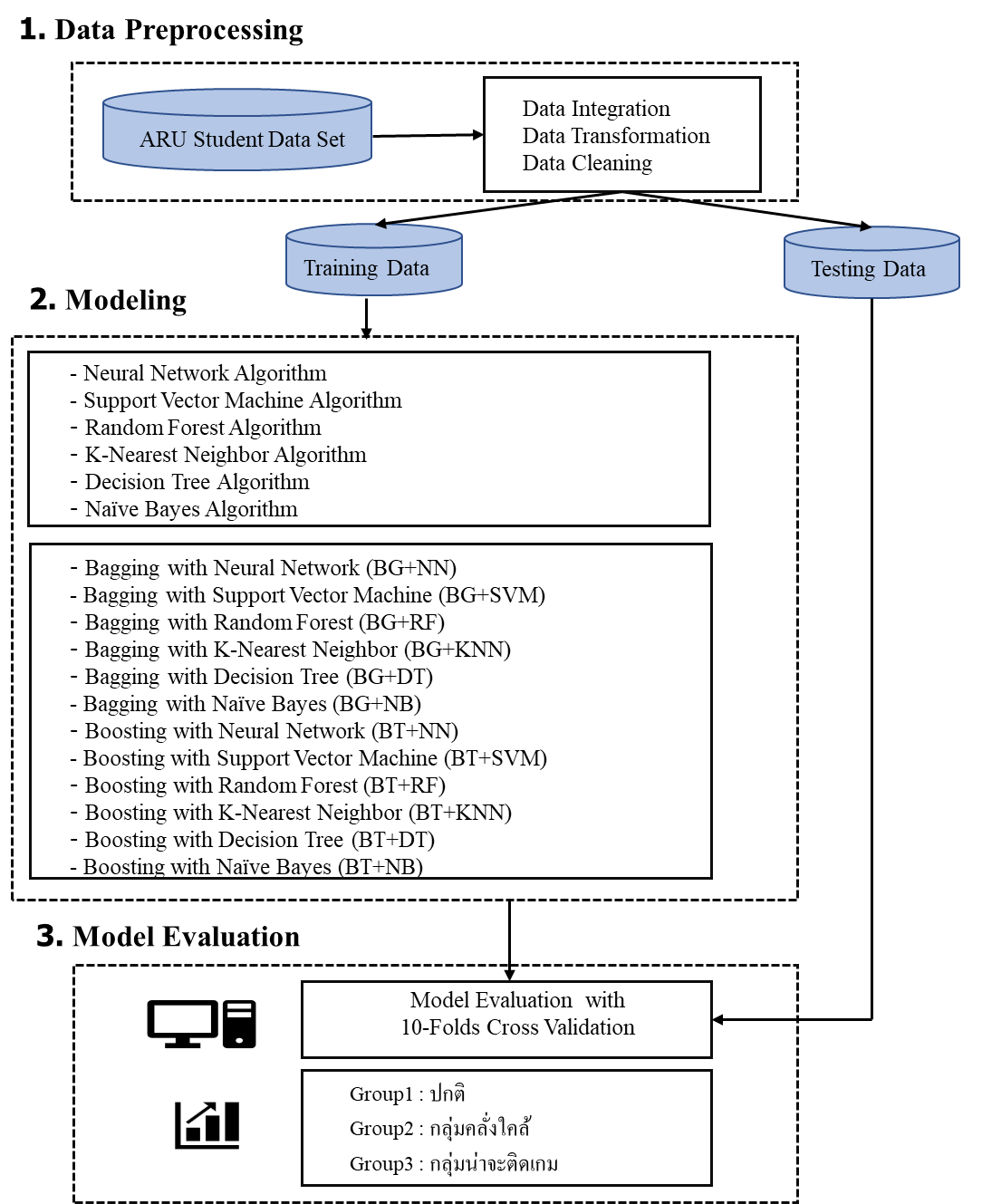โมเดลการพยากรณ์พฤติกรรมการติดเกมของนักศึกษามหาวิทยาลัยราชภัฏ ด้วยอัลกอริทึมการเรียนรู้ร่วมกันและโครงข่ายประสาทเทียม
Main Article Content
บทคัดย่อ
งานวิจัยนี้มีวัตถุประสงค์เพื่อ (1) ศึกษาพฤติกรรมการติดเกมของนักศึกษามหาวิทยาลัยราชภัฏ (2) สร้างโมเดลและเปรียบเทียบประสิทธิภาพโมเดลการพยากรณ์พฤติกรรมการติดเกม ด้วยอัลกอริทึมเหมืองข้อมูลพื้นฐาน 6 อัลกอริทึม ได้แก่ โครงข่ายประสาทเทียม การสุ่มป่าไม้ ซัพพอร์ตเวกเตอร์แมทชีน เค-เนียร์เรสเนเบอร์ ต้นไม้ตัดสินใจ และนาอีฟเบย์ และ (3) สร้างโมเดลและเปรียบเทียบประสิทธิภาพโมเดลการพยากรณ์พฤติกรรมการติดเกมด้วยอัลกอริทึมการเรียนรู้ร่วมกัน 12 อัลกอริทึม ได้แก่ แบ็คกิ้งร่วมกับ 6 อัลกอริทึมพื้นฐาน และ บูสติ่งร่วมกับ 6 อัลกอริทึมพื้นฐาน โดยเครื่องมือที่ใช้ในการวิจัยครั้งนี้ คือ แบบทดสอบการติดเกม และโปรแกรมแรพิดไมเนอร์สตูดิโอ 9 กลุ่มตัวอย่างเป็นนักศึกษาจากมหาวิทยาลัยราชภัฏพระนครศรีอยุธยา ผลการวิจัยพบว่า โมเดลที่มีประสิทธิภาพสูงสุด คือ การสร้างโดยแบ็คกิ้งร่วมกับโครงข่ายประสาทเทียม (98.00%) และบูสต์ติงร่วมกับโครงข่ายประสาทเทียม (97.60%) ตามลำดับ สรุปผลการวิจัยว่าควรนำโมเดลที่ดีที่สุดไปใช้ในการพัฒนาแอปพลิเคชัน เพื่อพยากรณ์พฤติกรรมการติดเกมของนักศึกษามหาวิทยาลัยราชภัฏ เป็นแนวทางในการหาสาเหตุของพฤติกรรมการติดเกม การเฝ้าระวังและช่วยเหลือผู้ที่มีปัญหาการติดเกมให้เหมาะสมและพัฒนาการเรียนรู้ของนักศึกษาให้มีประสิทธิภาพต่อไป
Article Details

อนุญาตภายใต้เงื่อนไข Creative Commons Attribution-NonCommercial-NoDerivatives 4.0 International License.
บทความที่ได้รับการตีพิมพ์ในวารสารฯ ท้ังในรูปแบบของรูปเล่มและอิเล็กทรอนิกส์เป็นลิขสิทธิ์ของวารสารฯ
เอกสารอ้างอิง
World Health Organization, “Inclusion of “gaming disorder.” in ICD-11” World Health Organization. Accessed: Nov. 8, 2021. [Online]. Available: https://www.who.int/news/item/14-09-2018-inclusion
-of-gaming-disorder-in-icd-11
WebMD, “Is video game addiction real?.” Webmd. Accessed: Jun. 20, 2021. [Online]. Available: https://www.webmd.com/mental-health/addiction/video-game-addiction?page=2
Q. Wang, H. Ren, J.Long, Y. Liu and T. Liu, “Research progress and debates on gaming disorder,” General Psychiatry., to be published, doi: 10.1136/gpsych-2019-100071.
R. Singsakda, Online Game Trends, Nonthaburi, Thailand: Department of International Trade Negotiations, 2020. (in Thai)
Department of Mental Health, “Children's problem with game addiction.” dmh. Accessed: Apr. 5, 2021. [Online]. Available: https://www.dmh.go.th/news-dmh/view.asp?id=30036 (in Thai)
C. Pornnophadol, B. Sornpaisan, K. Khamklieng and S. Pattanaamorn, “Development of a game addiction test,” Journal of the Psychiatric Association of Thailand, vol. 59, no. 1, pp. 3-14, 2014.
S. Sinsomboonthong, “An Efficiency comparison in prediction of child and adolescence game addition in bangkok,” Thai Science and Technology Journal, vol. 26, no. 3, pp. 405-16, 2018.
W. Inplang, “Opinion analysis on PUBG mobile game using text mining,” M.Sc. thesis, Dept. Information Technology., Mahasarakham University., Mahasarakham, Thailand, 2020.
S. Sun, J. Yang, Y.-H. Chen, J. Miao and M. Sawan, “EEG signals based internet addiction diagnosis using convolutional neural networks,” Applied Sciences, vol. 12, no. 13, pp. 6297, 2022.
E. Patcharawongsakda, An Introduction to data mining techniques, Bangkok, Thailand: Asia Digital Printing, 2014.
J. Han, M. Kamber and J. Pei, Data mining concepts and techniques, 3rd ed. Waltham, MA, USA: Morgan Kaufmann, 2012.
M. Kantardzic, Data mining: concepts, models, methods, and algorithms, 3rd ed. Hoboken, NJ, USA: John Wiley & Sons, 2019.
P. Tan, M. Steinbach, A. Karpatne and V. Kumar, Introduction to data mining, 2nd ed. Upper Saddle River , NJ, USA: Pearson Education; 2019.
I. H. Witten and E. Frank, Data mining: practical mane learning tools and techniques, 2nd ed. San Francisco, CA, USA: Morgan Kaufmann, 2017.
N. Rojanaburanon, “Rapid miner studio data analysis guide 9.” GotoKnow. Accessed: Mar. 25, 2021. [Online]. Available: https://www.gotoknow.org/posts/660127
E. Patcharawongsakda, Introduction to predictive modeling with rapidMiner studio 9, Bangkok, Thailand: Asia Digital Printing, 2021.
A. Charu C, “Neural Networks and Deep Learning” Springer, 2018.
M. H. Beale, M. Hagan and H.B. Demuth, Neural network toolbox 7 user’s guide, Natick, MA, USA: The MathWorks, Inc. 2010.
B. Elzkorn, “Data normalization and standardization.” Bluehost. Accessed: May. 26, 2021. [Online]. Available: http://www.benetzkorn.com/2011/11/data-normalization-and-standardization
L. Breiman, “Random forests,” Machine Learning, vol. 45, no. 1, pp. 5-32, 2001.
J. Ali, R. Khan, N. Ahmad and I. Maqsood, “Random forests and decision tree,” In JCSI International Journal of Computer Science, vol. 9, no. 5, pp. 272-278, 2012.
M. H. Dunham, Data mining: introductory and advanced topics, Upper Saddle River , NJ, USA: Pearson Education, 2006.
J. R. Quinlan, “Introduction of decision trees,” Machine Learning, vol. 1, no. 1, pp. 9-81, 1986.
S. De, S. Dey, S. Bhattacharyya and S. Bhatia, Data mining advanced data mining tools and methods for social computing, Cambridge, MA, USA: Academic Press, 2022.
S. Sinsomboonthong, Data mining 1, Bangkok, Thailand: King Mongkut's Institute of Technology Ladkrabang, 2017.
S. Euawatthanamongkol. Data mining, 2nd ed. Bangkok, Thailand: Institute of Development Administration, 2019.
T. G. Dietterich, “An Experimental comparison of three methods for constructing ensembles of decision trees: bagging, boosting and randomization,” Machine Learning, vol. 40, pp. 39–157, 2000.
N. Nai-Arun and P. Sittidech, “Ensemble learning model for diabetes classification,” Journal of Advanced Materials Research, vol. 931–932, pp. 1427-1431, 2014.
J. Hongvientiane, N. Lakkanurak and K. HengPhraPhrom, “A Comparison of the efficiency of the classification of autism disease using data mining technique,” in Proc. the 11th NPRU National Academic Conference, Nakhon Pathom, Thailang, Jul. 11-12, 2019, pp. 321-326.


